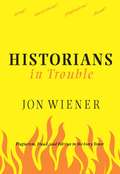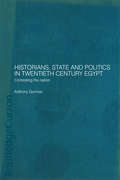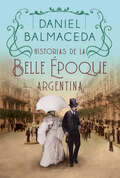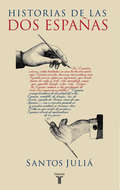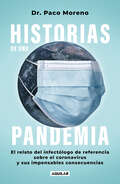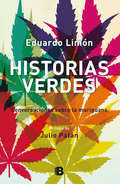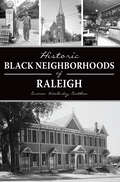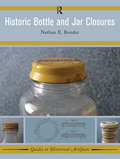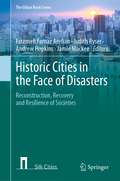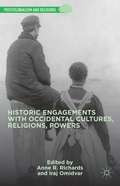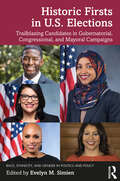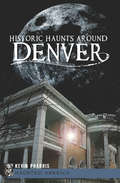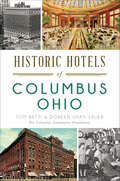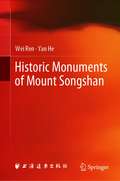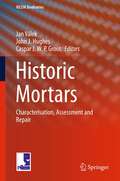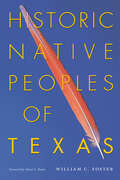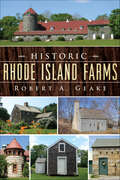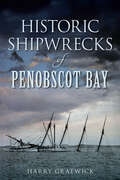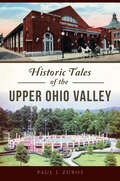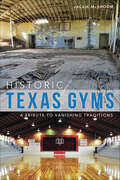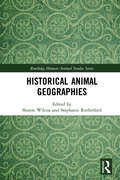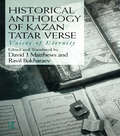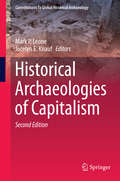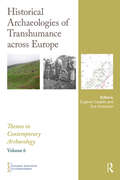- Table View
- List View
Historians in Trouble
by Jon WienerHistorians in Trouble is investigative journalist and historian Jon Wiener's "incisive and entertaining" (New Statesman, UK) account of several of the most notorious history scandals of the last few years.Focusing on a dozen key controversies ranging across the political spectrum and representing a wide array of charges, Wiener seeks to understand why some cases make the headlines and end careers, while others do not. He looks at the well publicized cases of Michael Bellesiles, the historian of gun culture accused of research fraud; accused plagiarists and "celebrity historians" Stephen Ambrose and Doris Kearns Goodwin; Pulitzer Prize-winner Joseph J. Ellis, who lied in his classroom at Mount Holyoke about having fought in Vietnam; and the allegations of misconduct by Harvard's Stephan Thernstrom and Emory's Elizabeth Fox-Genovese, who nevertheless were appointed by George W. Bush to the National Council on the Humanities.As the Bancroft Prize-winning historian Linda Gordon wrote in Dissent, Wiener's "very readable book . . . reveal[s] not only scholarly misdeeds but also recent increases in threats to free debate and intellectual integrity."
Historians, State and Politics in Twentieth Century Egypt: Contesting the Nation (Routledge Islamic Studies Series)
by Anthony GormanThis book deals with the relationship between historical scholarship and politics in twentieth century Egypt. It examines the changing roles of the academic historian, the university system, the state and non-academic scholarship and the tension between them in contesting the modern history of Egypt. In a detailed discussion of the literature, the study analyzes the political nature of competing interpretations and uses the examples of Copts and resident foreigners to demonstrate the dissonant challenges to the national discourse that testify to its limitations, deficiencies and silences.
Historias de la Belle Époque argentina
by Daniel BalmacedaUna invitación a recorrer los espléndidos años dorados de la Belle Époque argentina. De las últimas décadas del siglo XIX al Centenario de la Revolución de Mayo, en 1910, y los años previos a la Primera Guerra Mundial. Este libro es una invitación a recorrer los espléndidos años dorados de la Belle Époque argentina. De las últimas décadas del siglo XIX al Centenario de la Revolución de Mayo, en 1910, y los años previos a la Primera Guerra Mundial. Una época de gran prosperidad, cuando el porvenir era esperanza y desarrollo. Tiempos de inmigración masiva; de inicio del ocio, de la gastronomía, del transporte y de mujeres que, por primera vez, se animaban a reclamar sus derechos. Espiamos el diario de Delfina Bunge y sus observaciones de quienes iban a misa, asistimos a un baile de fin de año, presenciamos el primer llamado telefónico, la aparición de los autos eléctricos, el miedo frente al primer vuelo en avión y el caso cero de una temible vuelta de la fiebre amarilla. ¿Cómo eran los dandis por esos días? ¿Cuántos años tenía el niño que quiso matar a Roca? ¿Cómo desbarató José Hernández una edición trucha del Martín Fierro? Decenas de casos de emprendedores que armaron un imperio con una máquina rudimentaria en un sótano: de Fort a Rigolleau. Historias nacidas de la incansable búsqueda que Daniel Balmaceda realiza desde hace años en periódicos, revistas y documentos inéditos de todo tipo, para descubrir y rearmar las piezas perdidas de nuestra historia.
Historias de las dos Españas
by Santos JuliáUna historia coral de las sucesivas, contradictorias y enfrentadas historias de las dos Españas. «Dos Españas, señores, están trabadas en una lucha incesante», dijo en cierta ocasión Ortega, resumiendo con su proverbial aplomo una historia de siglos. Dos Españas que son, más que el resultado de un análisis, el gran relato de un pasado con el propósito de abrir un futuro: «una España muerta, hueca y carcomida y una España nueva, afanosa, aspirante, que tiende hacia la vida». De esa creación cultural y de los sujetos que la inventaron y la echaron a rodar trata este magistral libro de Santos Juliá, en un recorrido que abarca desde los primeros escritores públicos, testigos de la revolución liberal de principios del siglo XIX, a los jóvenes intelectuales de mediados del siglo XX, protagonistas de la recusación del gran relato de las dos Españas. Entre medias, la generación del 98, que dio a España por muerta; los catalanes, que despertaron a su nación para incrustarla en una Espanya gran; las gentes del 14, que hablaron de una España viva; los jóvenes de la República, que acabaron llorando su pérdida; los católicos, que salieron a su reconquista; y los fascistas, que la soñaron, unida e imperial, a orillas del Arlanzón. ** Obra galardonada con el Premio Nacional de Historia de España 2005.
Historias de muerte y corrupción: Calderón, Mouriño, Zambada, El Chapo, La reina del Pacífico
by Julio Scherer García"Sin medir la magnitud del problema que enfrentaba, Calderón se metió entero en el agua helada de un océano sin orillas. Ignoró o no fue consciente de que el narco se había infiltrado en las capas altas, medias y bajas de la sociedad a lo largo de cincuenta años de priísmo complaciente y durante el periodo del foxismo cómplice." Julio Scherer García Las historias que escribe Julio Scherer García en este libro responden a la brutalidad del México de nuestros días. "El narco está en la sociedad, arraigado como la corrupción", explicó el Mayo Zambada en la entrevista que el autor le hizo en marzo de 2010. En estas páginas, donde se revelan los entretelones y las secuelas de aquel encuentro, Scherer nos relata cómo el crimen organizado ha permeado todos los órdenes de la vida nacional, dejando un país incendiado por la violencia y regido por la descomposición, la impunidad, el encubrimiento y la violación de los derechos humanos. Estas historias de muertey corrupción tienen como protagonistas, además de los narcos, a los gobernantes, los policías, los políticos, los jueces, los soldados, los niños sicarios y los civiles caídos en la guerra "que no lucha" contra la delincuencia organizada. Estos últimos forman parte de las descarnadas estadísticas, enlistados como "daños colaterales" y, según registra fehacientemente el autor, de ellos se responsabiliza el comandante supremo de nuestras Fuerzas Armadas. Así, como primera conclusión, la respuesta a la pregunta que aquí se plantea resulta clave: ¿podría juzgarse al presidente por los inocentes muertos? "Detrás de cada víctima "apunta Scherer" hay un nombre, un apellido, una historia, pero llegará el día del rendimiento de cuentas por parte de quienes se vieron envueltos en esta tragedia que no cesa."
Historias de una pandemia: El relato del infectólogo de referencia sobre el coronavirus y sus impesansables consecuencias
by Paco Moreno"Paco, con su conocimiento y valentía, fue el infectólogo que a muchos nos trajo la luz en la oscuridad de esta pandemia. En este libro describe, con la claridad que lo caracteriza, lo que todos vivimos estos últimos años. Recomiendo su lectura ampliamente." -ARTURO ELIAS AYUR En diciembre de 2019 la noticia de una neumonía desconocida que asolaba a la ciudad china de Wuhan parecía un relato de ciencia ficción. Algunos meses más tarde, las es-cenas apocalípticas de metrópolis desiertas, hospitales desbordados y millones de personas confinadas se repetían por todo el mundo: era el inicio de la pandemia del coronavirus. El doctor e infectólogo Paco Moreno, quien estuvo en la primera línea de batalla contra este virus, fue un testigo privilegiado del avance devastador de la pandemia. Desde su trinchera, Moreno rescata historias de coraje y sobrevivencia, y también de quienesperdieron a sus seres queridos; de aquellos hombres de ciencia que, poniendo su vida en riesgo, no cesaron de buscar una cura; de aquellos errores políticos que se tradujeron en cientos de miles de muertes que pudieron haberse evitado. A la par, sus explicaciones en torno a las vacunas, el sistema inmunológico y el funcionamiento del virus, entre otras, enriquecen estas páginas. Pero fundamentalmente que-dan aquí los testimonios del espíritu humano ante la adversidad y lo desconocido, así como las reflexiones y enseñanzas que la pandemia nos ha dejado y que debemos atender si queremos un mejor futuro.
Historias verdes: Conversaciones sobre la mariguana
by Eduardo Limón¿Fumar o no fumar?, ésa es la cuestión a la que se enfrenta nuestra conciencia el día en que, por primera vez, se presenta ante nosotros la posibilidad de darse un "toque", o, más comúnmente dicho: un churro de mota. Escritores, músicos, científicos, promotores culturales y hasta tres dealers se dan cita en las páginas de Historias verdes para hablar del singular momento en que se encontraron con la mítica planta. Cada uno crea una crónica de su vida a partir de ese episodio; leer estos testimonios resulta pertinente frente al debate de la posible legalización de la mariguana en México. Eduardo Limón, periodista y escritor de gran trayectoria, conduce estas conversaciones y comparte algunas experiencias, y lejos de tomar una postura ante este polémico tema, apuesta por conciliar los gustos, las aversiones, los pros y contras en el consumo de la cannabis. Conversaciones con Fernando Rivera Calderón, Bef, Paco Ignacio Taibo II, Armando Vega-Gil, Joselo, Xavier Velasco, Ana Clavel, Fernanda Melchor, Ruzo, Juan Ramón de la Fuente y tres dealers. ¿Hay algo más humano que drogarse? FERNANDA MELCHOR Mariguana: un tema que dejó de ser prohibido y se volvió controvertido. JUAN RAMÓN DE L A FUENTE
Historic Black Neighborhoods of Raleigh (American Heritage)
by Carmen Wimberley CauthenThe story of Raleigh's African American communities begins before the Civil War.Towns like Oberlin Village were built by free people of color in the antebellum era. During Reconstruction, the creation of thirteen freedmen's villages defined the racial boundaries of Raleigh. These neighborhoods demonstrate the determination and resilience of formerly enslaved North Carolinians. After World War II, new suburbs sprang up, telling tales of the growth and struggles of the Black community under Jim Crow. Many of these communities endure today. Dozens of never before published pictures and maps illustrate this hidden history.Local historian Carmen Wimberly Cauthen tells the story of a people who--despite slavery--wanted to learn, grow, and be treated as any others.
Historic Bottle and Jar Closures (Guides To Historical Artifacts Ser. #6)
by Nathan E BenderThis book presents a much-needed review of commercial closures for bottles and jars used in America prior to World War II. Archaeological attention to commercial closures has been rather limited. This is surprising given that data derived from bottles and jars pertain to a wide range of studies, including chronological control, trade, site functions, and methods of manufacture. Closures are an integral part of these studies, becoming particularly important after a spectacular variety of metal and glass caps in the late nineteenth and early twentieth centuries. This volume-provides a comprehensive review, including detailed closure definitions, as well as glass finishes;-discusses the history of the development and impact of the hermetic seal in commercial closures;-will appeal to students, professionals, and collectors studying this common historic artifact class.
Historic Cities in the Face of Disasters: Reconstruction, Recovery and Resilience of Societies (The Urban Book Series)
by Fatemeh Farnaz Arefian Andrew Hopkins Judith Ryser Jamie MackeeThis book examines reconstruction and resilience of historic cities and societies from multiple disciplinary and complementary perspectives and, by doing so, it helps researchers and practitioners alike, among them reconstruction managers, urban governance and professionals. The book builds on carefully selected and updated papers accepted for the 2019 Silk Cities international conference on ‘reconstruction, recovery and resilience of historic cities and societies’, the third Silk Cities conference held in L’Aquila, Italy, 10-12 July 2019, working with University of L’Aquila and UCL.This multi-scale, and multidisciplinary book offers cross-sectoral and complimentary voices from multiple stakeholders, including academia, urban governance, NGOs and local populations. It examines post-disaster reconstruction strategies and case studies from Europe, Asia and Latin America that provide a valuable collection for anyone who would like to get a global overview on the subject matter. It thereby enables a deeper understanding of challenges, opportunities and approaches in dealing with historic cities facing disasters at various geographical scales. Additionally, it brings together historical approaches to the reconstruction of historical cities and those of more recent times. Thus, it can be used as a reference book for global understanding of the subject matter.
Historic Engagements with Occidental Cultures, Religions, Powers
by Anne R. Richards Iraj OmidvarThis book explores centuries of power relations and imperial and civilizing rhetorics, overarching themes highlighted in these infrequently heard accounts by eastern travelers to the West. Considered in depth are evolutions in mental frameworks and practices that led to the emergence of anticolonial consciousness and strategies of protest.
Historic Firsts in U.S. Elections: Trailblazing Candidates in Gubernatorial, Congressional, and Mayoral Campaigns (Race, Ethnicity, and Gender in Politics and Policy)
by Evelyn M. SimienHistoric Firsts in U.S. Elections:Trailblazing Candidates in Gubernatorial, Congressional, and Mayoral Campaigns examines barrier-breaking figures across various types of elective offices and constituent groups. The moment in which historic firsts enter the electoral arena, and the unique campaigns that ensue, are shown to be symbolically empowering. These change agents on the campaign trail become lighting rods for more liberal policies, and their candidacies are tied to questions of representation, electability, and performance. The distinctive combinations of race, ethnicity, and gender identities represented here translate into voter excitement to go to the polls and participate in other ways. Original chapters by respected scholars and practitioners consider how recent breakthrough elections are similar to yet different from past elections for gubernatorial, congressional, and mayoral offices. The shadow of Donald Trump’s wildly unconventional U.S. presidency looms over this groundbreaking analysis, linking local to national level politics. For students of politics across the curriculum, this book expands the theoretical capacity of intersectionality research and links it to voter mobilization and electoral success.
Historic Haunts Around Denver (Haunted America)
by Kevin PharrisThe author of The Haunted Heart of Denver goes beyond the city limits to investigate the supernatural surroundings of Colorado&’s capital. In Denver, the spirits aren&’t just penned to the city center. No, even the suburbs and outlying cities have the kind of history that could give quite a fright to the unsuspecting. Folks might be surprised to learn that a house in northwest Denver comes fully equipped with a basement theater—and spectral performers as well—and former phantom residents still roam their old homestead in what is now an Adams County open space. From Westminster&’s Bowles House Museum, where even the ghosts were involved in renovations, to Littleton&’s Melting Pot restaurant, a former Carnegie library that offers diners a side of the supernatural, accidental ghost hunter Kevin Pharris explores further tales of supernatural haunts and unexplained phenomena surrounding the Mile High City. Includes photos!
Historic Hotels of Columbus, Ohio (Landmarks)
by Tom BettiThough only a handful remain today, the Capital City once boasted a wealth of illustrious hotels and raucous two-bit establishments. Grande dame hotels like the Neil House, the Great Southern, the Hartman, the Chittenden and the Deshler achieved the height of elegance and refinement. More modest establishments were frequented by fugitive Confederate generals, notorious bootleggers and Fidel Castro's family. Join the Gilded Age bachelors who decked out banquet halls to look like camping sites and the Hungarian revolutionaries who failed to keep a low profile. From devastating hotel fires to ornate outhouse fittings, authors Tom Betti and Doreen Uhas Sauer introduce you to a whole new side of Columbus history.
Historic Monuments of Mount Songshan
by Yan He Wei RenThis book tells the story of the Mount Songshan area architecture in simple terms, while also providing detailed information on the history of Buddhist architecture. The history of the Mount Songshan area can be traced back to the Xia Dynasty in the 23rd century B.C. The heritage architecture in this area has seen the rise and fall of various powers – including the Han Dynasty, Northern Wei Dynasty, Tang and Song Empires, Jin Dynasty, Yuan Dynasty, and the Ming and Qing Empires – and reflects the character of each historical period. Over the past 2,000 years, history has been continuously woven into the architecture. The Mount Songshan area is, therefore, a perfect representation of the perpetual Chinese civilization, and the most magnificent museum of ancient Chinese architecture. Most importantly, these various types of architecture offer valuable insights into the architectural design and technologies of each historical period. The products of ingenuity and innovation, they are marvellous creations that ancient Chinese people took great pride in.
Historic Mortars
by Caspar J. Groot Jan Válek John J. HughesThis volume focuses on research and practical issues connected with mortars on historic structures. The book is divided into four sections: Characterisation of Historic Mortars, Repair Mortars and Design Issues, Experimental Research into Properties of Repair Mortars, and Assessment and Testing. The papers present the latest work of researchers in their field. The individual contributions were selected from the contributions to the 2nd Historic Mortars Conference, which took place in Prague, September, 22-24, 2010. All papers were reviewed and improved as necessary before publication. This peer review process by the editors resulted in the 34 individual contributions included in here. One extra paper reviewing and summarising State-of-the-Art knowledge covered by this publication was added as a starting and navigational point for the reader. The editors believe that having these papers in print is important and they hope that it will stimulate further research into historic mortars and related subjects.
Historic Native Peoples of Texas
by William C. FosterSeveral hundred tribes of Native Americans were living within or hunting and trading across the present-day borders of Texas when Cabeza de Vaca and his shipwrecked companions washed up on a Gulf Coast beach in 1528. Over the next two centuries, as Spanish and French expeditions explored the state, they recorded detailed information about the locations and lifeways of Texas's Native peoples. Using recent translations of these expedition diaries and journals, along with discoveries from ongoing archaeological investigations, William C. Foster here assembles the most complete account ever published of Texas's Native peoples during the early historic period (AD 1528 to 1722). Foster describes the historic Native peoples of Texas by geographic regions. His chronological narrative records the interactions of Native groups with European explorers and with Native trading partners across a wide network that extended into Louisiana, the Great Plains, New Mexico, and northern Mexico. Foster provides extensive ethnohistorical information about Texas's Native peoples, as well as data on the various regions' animals, plants, and climate. Accompanying each regional account is an annotated list of named Indian tribes in that region and maps that show tribal territories and European expedition routes. This authoritative overview of Texas's historic Native peoples reveals that these groups were far more cosmopolitan than previously known. Functioning as the central link in the continent-wide circulation of trade goods and cultural elements such as religion, architecture, and lithic technology, Texas's historic Native peoples played a crucial role in connecting the Native peoples of North America from the Pacific Coast to the Southeast woodlands.
Historic Rhode Island Farms (Landmarks)
by Robert A. GeakeDating back to the colonial era, the historic barns and outbuildings of Rhode Island have withstood the test of time. From the state's early barnyard taverns to the modern-day horse and dairy farms that populate rural Rhode Island, each of these buildings has a story to tell. In the mid-eighteenth century, the Narragansett planters bred horses on their farms in southern Rhode Island. Later, dairy farms sprang up across the region. Milking barns were built on the largest farms in the state, including the Theinhert Dairy Farm and Barn in Lincoln. Before the advent of electric trolleys, urban barns sheltered horses for early tramcar transportation. Each barn is a beloved reminder of the state's history. Join author Robert A. Geake as he explores the origins and evolution of Rhode Island's farms.
Historic Shipwrecks of Penobscot Bay (Disaster Ser.)
by Harry GratwickAn in-depth history of the Maine inlet&’s most historic and dramatic shipwrecks. Thousands flock to the beautiful coastline along Penobscot Bay every year, but the dark sea has often turned treacherous. Temperamental skies become stormy without notice; violent gales challenge even the most seasoned captains. Craggy rocks can be virtually invisible to oncoming vessels, like the Alice E. Clark, which simply strayed off course in good weather. Other ships, like the Governor Bodwell and Royal Tar, were destroyed by fire. But not all the ships were a total loss—some were repaired and resumed life under different names. Local author Harry Gratwick explores some of Penobscot Bay&’s most historic and dramatic shipwrecks, from what caused the wrecks to what happened during those fateful moments when the ships were going down.
Historic Tales of the Upper Ohio Valley (American Chronicles)
by Paul ZurosLocal historian Paul J. Zuros weaves a rich narrative of the region, reliving these tales as only a local can. The Upper Ohio River runs along the border between West Virginia and Ohio, where the cities of Weirton and Steubenville face each other across the flowing water. The history of these two municipalities has been intertwined from their earliest days. Discover stories of the early pioneers on both sides of the river and what they learned about their Native American predecessors. Tales of bygone celebrations will entertain, and rumors of local haunts will chill readers to the bone. The stories of these industrial centers as well as their preindustrial past will intrigue and delight young and old.
Historic Texas Gyms: A Tribute to Vanishing Traditions (Landmarks)
by Jackie McBroomFor generations of small-town Texans, the school gymnasium was the hub of the community. If it was a Tuesday night in Texline, most folks could be found in the old tin barn of a gym, rooting for their Tornadoes against the arch-rival Adrian Matadors. Transcending the role of a sports arena, the gym also provided a place to gather in celebration or shelter in crisis. Sadly, with the dramatic reduction of school districts around the state, many of the polished floorboards that once hosted graduations and beauty pageants now splinter beneath the weight of storage, farm equipment and guano-covered junk. From the pickup basketball game Elvis played in Hawkins to the tragic account of four Ennis war heroes, Jackie McBroom recounts stories from these beloved halls.
Historical Animal Geographies (Routledge Human-Animal Studies Series)
by Stephanie Rutherford Sharon WilcoxArguing that historical analysis is an important, yet heretofore largely underexplored dimension of scholarship in animal geographies, this book seeks to define historical animal geography as the exploration of how spatially situated human–animal relations have changed through time. This volume centers on the changing relationships among people, animals, and the landscapes they inhabit, taking a spatio-temporal approach to animal studies. Foregrounding the assertion that geography matters as much as history in terms of how humans relate to animals, this collection offers unique insight into the lives of animals past, how interrelationships were co-constructed amongst and between animals and humans, and how nonhuman actors came to make their own worlds. This collection of chapters explores the rich value of work at the contact points between three sub-disciplines, demonstrating how geographical analyses enrich work in historical animal studies, that historical work is important to animal geography, and that recognition of animals as actors can further enrich historical geographic research.
Historical Anthology of Kazan Tatar Verse
by David Matthews Ravil BukharaevThis anthology expounds the rich history of Kazan Tatar poetry, which has its beginnings in the early 12th century. Poets bear witness to the cultural, political as well as spiritual history of their nations, and in this sense, the history of poetry is the history of the nation. The authors try to single out the main themes of Kazan Tatar poetry in every epoch and period of time, the most penetrating of which is the theme of forceful alienation from one's motherland. The anthology unfolds against a rich and colourful background of social, cultural and political settings of each epoch, and presents Kazan Tatar poetry as it is, preserving its rhythmical, visual and rhyming structure supported by commentaries.
Historical Archaeologies of Capitalism
by Mark P. Leone Jocelyn E. KnaufThis new edition of Historical Archaeologies of Capitalism shows where the study of capitalism leads archaeologists, scholars and activists. Essays cover a range of geographic, colonial and racist contexts around the Atlantic basin: Latin America and the Caribbean, North America, the North Atlantic, Europe and Africa. Here historical archaeologists use current capitalist theory to show the results of creating social classes, employing racism and beginning and expanding the global processes of resource exploitation. Scholars in this volume also do not avoid the present condition of people, discussing the lasting effects of capitalism's methods, resistance to them, their archaeology and their point to us now. Chapters interpret capitalism in the past, the processes that make capitalist expansion possible, and the worldwide sale and reduction of people. Authors discuss how to record and interpret these. This book continues a global historical archaeology, one that is engaged with other disciplines, peoples and suppressed political and economic histories. Authors in this volume describe how new identities are created, reshaped and made to appear natural. Chapters in this second edition also continue to address why historical archaeologists study capitalism and the relevance of this work, expanding on one of the important contributions of historical archaeologies of capitalism: critical archaeology.
Historical Archaeologies of Transhumance across Europe (Themes in Contemporary Archaeology)
by Eugene Costello Eva SvenssonTranshumance is a form of pastoralism that has been practised around the world since animals were first domesticated. Such seasonal movements have formed an important aspect of many European farming systems for several thousand years, although they have declined markedly since the nineteenth century. Ethnographers and geographers have long been involved in recording transhumant practices, and in the last two decades archaeologists have started to add a new material dimension to the subject. This volume brings together recent advances in the study of European transhumance during historical times, from Sweden to Spain, Romania to Ireland, and beyond that even Newfoundland. While the focus is on the archaeology of seasonal sites used by shepherds and cowherds, the contributions exhibit a high degree of interdisciplinarity. Documentary, cartographic, ethnographic and palaeoecological evidence all play a part in the examination of seasonal movement and settlement in medieval and post-medieval landscapes. Notwithstanding the obvious diversity across Europe in terms of livestock, distances travelled and socio-economic context, an extended introduction to the volume shows that cross-cutting themes are now emerging, including mobility, gendered herding, collective land-use, the agency of non-elite people and competition for grazing and markets. The book will appeal not only to archaeologists, but to historians, geographers, ethnographers, palaeoecologists and anyone interested in rural lifeways across Europe.
